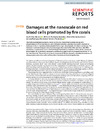Identificador persistente para citar o vincular este elemento:
https://accedacris.ulpgc.es/jspui/handle/10553/114248
| Campo DC | Valor | idioma |
|---|---|---|
| dc.contributor.author | Diaz-Marrero, Ana R. | en_US |
| dc.contributor.author | Gonzalez, MCR | en_US |
| dc.contributor.author | Creus, AH | en_US |
| dc.contributor.author | Rodríguez Hernández, Adriana | en_US |
| dc.contributor.author | Fernandez, JJ | en_US |
| dc.date.accessioned | 2022-03-29T12:53:51Z | - |
| dc.date.available | 2022-03-29T12:53:51Z | - |
| dc.date.issued | 2019 | en_US |
| dc.identifier.issn | 2045-2322 | en_US |
| dc.identifier.uri | https://accedacris.ulpgc.es/handle/10553/114248 | - |
| dc.description.abstract | The hydrocoral Millepora alcicornis, known as fire coral, biosynthesize protein toxins with phospholipase A2 (PLA2) activity as a main defense mechanism; proteins that rapidly catalyse the hydrolysis at the sn-2 position of phosphatidylcholine-type phospholipids of cellular membranes. This hydrolysis mechanism triggers a structural damage in the outer leaflet of the red blood cells (RBC) membrane, by generating pores in the lipid bilayer that leads to a depletion of the cellular content of the damaged cell. A secondary mechanism, tentatively caused by pore-forming proteins toxins (PFTs), has been observed. The use of atomic force microscopy (AFM) has allowed to visualize the evolution of damages produced on the surface of the cells at the nanoscale level along the time. | en_US |
| dc.language | eng | en_US |
| dc.relation | CTQ2014-55888-C03-01-R | en_US |
| dc.relation | INTERREG-MAC/1.1b/042 | en_US |
| dc.relation | Seguimiento, control y mitigación de proliferaciones de organismos marinos asociadas a perturbaciones humanas y cambio climático en la región Macaronésica | en_US |
| dc.relation.ispartof | Scientific Reports | en_US |
| dc.source | Scientific Reports [ISSN 2045-2322], v. 9, 14298 | en_US |
| dc.title | Damages at the nanoscale on red blood cells promoted by fire corals | en_US |
| dc.type | info:eu-repo/semantics/article | en_US |
| dc.type | Article | en_US |
| dc.identifier.doi | 10.1038/s41598-019-50744-6 | en_US |
| dc.identifier.pmid | 31586105 | - |
| dc.identifier.scopus | 2-s2.0-85072910142 | - |
| dc.identifier.isi | WOS:000489011000006 | - |
| dc.contributor.orcid | 0000-0002-8886-7519 | - |
| dc.contributor.orcid | #NODATA# | - |
| dc.contributor.orcid | #NODATA# | - |
| dc.contributor.orcid | #NODATA# | - |
| dc.contributor.orcid | 0000-0002-0805-8317 | - |
| dc.identifier.issue | 1 | - |
| dc.investigacion | Ciencias | en_US |
| dc.type2 | Artículo | en_US |
| dc.utils.revision | Sí | en_US |
| dc.identifier.ulpgc | Sí | en_US |
| dc.contributor.buulpgc | BU-BAS | en_US |
| dc.description.sjr | 1,341 | |
| dc.description.jcr | 3,998 | |
| dc.description.sjrq | Q1 | |
| dc.description.jcrq | Q1 | |
| dc.description.scie | SCIE | |
| item.fulltext | Con texto completo | - |
| item.grantfulltext | open | - |
| crisitem.project.principalinvestigator | Acosta Arbelo, Félix Antonio | - |
| crisitem.author.dept | GIR ECOAQUA: Biodiversidad y Conservación | - |
| crisitem.author.dept | IU de Investigación en Acuicultura Sostenible y Ec | - |
| crisitem.author.orcid | 0000-0002-2785-4458 | - |
| crisitem.author.parentorg | IU de Investigación en Acuicultura Sostenible y Ec | - |
| crisitem.author.fullName | Rodríguez Hernández,Adriana | - |
| Colección: | Artículos | |
Citas SCOPUSTM
5
actualizado el 08-jun-2025
Citas de WEB OF SCIENCETM
Citations
4
actualizado el 08-jun-2025
Visitas
65
actualizado el 27-abr-2024
Descargas
35
actualizado el 27-abr-2024
Google ScholarTM
Verifica
Altmetric
Comparte
Exporta metadatos
Los elementos en ULPGC accedaCRIS están protegidos por derechos de autor con todos los derechos reservados, a menos que se indique lo contrario.
